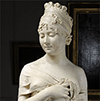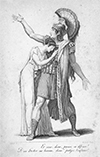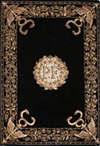| |
| |
EDITORIAL > THE BATTLE OF WATERLOO AND THE CONCEPT OF WAR CRIMES
This week, we received an interesting question on napoleon.org, namely: "Did the British and Prussians commit war crimes against the French soldiers, either those wounded or taken prisoner?". Worth commenting on here in the Bulletin, we thought.The Battle of Waterloo was, as everyone knows, one of the Empire's most deadly clashes, with the violence between soldiers reaching climactic levels for the period. But, it was a violence that was shared by both sides. On the one hand, it was reported by the quartermaster Varlet that 400 soldiers of the guard were executed on the evening of 18 June (claim that, it is fair to say, no other research has so far confirmed), and we have a great deal of evidence for the fact that the Prussian and British pursuit was ruthless. On the other, the French General Roguet reportedly told his officers on the morning of Ligny: "Tell your grenadiers that the first man who brings me a Prussian prisoner will be shot".There were many massacres of prisoners throughout the wars of the Revolution and the Empire; the Belgian campaign was not unique. Such events occurred at Austerlitz (on the French side in the same terms as those of Roguet on the morning at Ligny), during the campaign in Russia (on both Russian and French sides), at Leipzig (on the Prussian and Austrian sides) during the French Campaign (on French and allied sides). All this is without mentioning Spain: where the taking of Saragossa by French troops, for example, was of a degree of savagery beyond limits. And this was a response to the equally systematic massacres of Imperial soldiers by the Spaniards. As for the British troops, they behaved so badly (even according to Wellington) that they ended up being as much hated by the Spaniards and Portuguese as Napoleon's soldiers were.It is important to emphasize that there was no law of war at the time. The Jus gentium (“law of nations”), which existed, was a set of customary principles, respected or not by the warring nations, without the guarantee of any international treaty, and much less controlled by overseeing ombudsmen. By extension, there was no court to try what we would call today "war crimes". This concept (of crime in war) therefore must be used with caution, even though indeed some warlike practices of the time might now be the subject of international tribunals, and in them, all of all the warring nations would have been incriminated.
François Houdecek
Project Manager of the Correspondance de Napoléon at the Fondation Napoléon

|
|
|
| |
OBJECT OF THE MONTH > EGYPTIAN TEA-SERVICE
Composed of a teapot and 9 cups and saucers, this tea set was part of a much larger porcelain service ordered by Napoleon for Josephine in 1810 just after their divorce. The Empress chose the design which is a replica of the service offered as a diplomatic gift to the Tsar by Napoleon. Now in the collection of the Fondation Napoleon, pieces are currently on loan for two exhibitions: “Napoléon 1er ou la légende des arts”, and “Napoléon/Wellington: destins croisés”.

|
|
|
| |
COMMEMORATION OF THE DEATH OF THE EMPEROR > 5 MAY AT LES INVALIDES, FRANCE
Organised by the Gouverneur militaire de Paris, le Gouverneur des Invalides and the Imperial Family, the annual mass in memory of the first Emperor Napoleon and of soldiers who died for France will take place on 5 May at the Cathedral Saint-Louis des Invalides at 18h30, presided by HIH the Prince Napoléon and General Jean-Louis Georgelin, Grand-Chancelier of the Légion d'Honneur, representing the President of France, François Hollande. The mass will be preceded, at 18h, by the laying of wreaths, including one from the Fondation Napoléon, at the foot of the Emperor's tomb beneath the dome of Les Invalides.

|
|
|
| |
EXHIBITION > NAPOLEON AND THE LEGEND OF THE ARTS, 1800-1815
A new exhibition opening today at the Palais de Compiègne “Napoléon Ier ou la légende des Arts, 1800 –1815” explores the artistic legacy of the First Empire, in particular the decorative arts whose influence spread through Europe for most of the 19th Century. The Fondation Napoléon has lent several objects from its collection, including Josephine's slippers, parts of her Egyptian tea set (our “object of the month”, see above) and the Duchess of Otrante's travelling case.
Produced in collaboration with the Royal Castle of Warsaw, the exhibition will travel to Warsaw later in the year, where it will be enriched with exhibits from Polish collections.

|
|
|
| |
NAPOLEON'S IOO DAYS IN THE LIMELIGHT
On the 21 April 1815, Napoleon attended a performance of Jean-Charles-Julien Luce de Lancival's tragedy “Hector” at the Comédie Française in Paris, arriving in a very theatrical manner himself half way through the first act. You can find out more about how the theatre was itself a stage for the playing out of Napoleon's political power, at the on-line exhibition “The Last Stand: 100 days in 100 objects”, produced by Warwick University with contributions from notable napoleonic scholars, which is well worth following, as a new object is revealed each day for the duration of the bicentenary of Napoleon's “100 days” this year. Katherine Astbury, curator of the online exhibition, further explores the subject in her recent article for The Conversation, “Napoleon's battle for Parisian hearts largely took place on stage”.(external links).

|
|
|
| |
30 APRIL 1803 > THE LOUISIANA SALE
On 30 April 1803, the official sale of Louisiana was concluded between France and the United States. As Andrew Roberts points out in his recent biography of Napoleon I, “The Americans paid France 80 million francs for 875,000 square miles of territory that today comprises all or some of thirteen states from the Gulf of Mexico across the Midwest right up to the Canadian border, at a cost of less than four cents an acre.” (see recent article in the advocate, external link). You can also find out more in our detailed on-line dossier.
200 YEARS AGO > THE BONAPARTES REGROUP...
When Napoleon left Elba, it was too dangerous for his mother, Letizia, and his sister, Pauline, who had been keeping him company on the island, to go with him. Only on 10 March, after arriving in Lyons, did Napoleon give permission for his mother to join him in France. Letizia boarded the Joachim, a vessel provided by Murat and Caroline to ferry her to Naples. At Portici (an Italian city in the gulf of Naples), she was joined by her half-brother Cardinal Fesch and her youngest son Jérôme, who had fled Trieste where he had been under Austrian surveillance. The family members set sail on 20 April for Gaeta (a coastal city in the province of Latina, in Lazio, central Italy), planning to board La Dryade there, which would take them to France. The voyage was delayed as they tried to dodge the Royal Navy, and eventually they only arrived on the French coast at Golfe-Juan on 22 May. Earlier, on 13 May, they had been able to put in at Bastia, where Letizia was to see Corsica for what would be the last time in her life. She arrived in Paris on 1 or 2 June. Meanwhile, Pauline had not waited for Napoleon's nod to leave Elba. On 4 March, she had boarded a felucca with her ladies in waiting, landing in Viareggio on 6 March and lodging at the country house in Campignano. This stately residence belonged to her sister Elisa, the former Grand Duchess of Tuscany. As for Elisa, she had taken refuge in Bologna, where she would soon be arrested and sent to prison in Moravia. Pauline had more luck. Although she was immediately arrested by the Austrians upon the orders of the new Grand Duke of Tuscany, Ferdinand, brother of Franz I of Austria, her poor health meant that she was allowed to stay in Campignano. On 5 June, she was even allowed to take the waters at Lucca. Napoleon ordered his ministers Decrès and Caulaincourt to take up Pauline's cause with the Grand Duke, Ferdinand, and sent La Dryade to bring her from Livorno to France. But the events of June 1815 meant otherwise, and Pauline stayed in Lucca until October.
150 YEARS AGO - START OF NAPOLEON III'S SECOND VIST TO ALGERIA
On the 29th April 1865, the Moniteur Universel announced the departure of Napoleon III on what was to be his second voyage to Algeria. Leaving Paris by train from the Gare de Lyon, he arrived in Marseilles the next day. The same day as his departure letters patent were sent to the Senate (and also reproduced in the Moniteur Universel, 30 April) conferring on her Majesty the Empress Eugénie the title of Regent in Louis-Napoléon's absence. On the 1st of May, Napoleon III set sail on the Imperial yacht, Aigle (see a model of this famous ship in our dossier about the inaugural voyage down the Suez Canal) accompanied by several frigates, and arrived in the port of Alger early the next morning. On the occasion of his first voyage, in 1860, Napoleon III, with the Empress and the Prince Imperial, had disembarked directly onto the shore. This time, he would be welcomed onto a newly-built quay. Other work had also been accomplished since his last visit, such as the construction of the Boulevard de l'Impératrice. Soon after his arrival, the Emperor would urge Europeans to “treat the Arabs among whom you must live as your compatriots” and on the 5 May he gave a speech in Alger addressed specifically to Muslims. He visited installations in Alger on foot as well as by carriage. From 6 to 8 May he visited Mitidja, and he took the train from the newly-built railway station to Blida, and then by carriage to Médéa , and later embarked for Oran, then Sidi Bel-Abbes, Mostaganem… He would also see Kabylie where there was fighting. All in all, it was a very intense journey in which the Emperor covered over 3,000 km by carriage, alternating working meetings and contacts with both civilians and the military, Europeans and locals. This voyage would give rise to important reforms upon his return in early July (which we will explore in more detail in a future Bulletin).
To find out more about Napoleon III's two voyages to Algeria have a look at our website (article in French) or read the official contemporary (1865) account of it on-line here (in French, external link). There is also an early photographic album of Algeria including images of Napoleon III's visit conserved at the Bibliothèque National de France which can be seen on-line here (external link).
Wishing you an excellent Napoleonic week!
Peter Hicks and Rebecca Young (with Syamala Roberts)
THE NAPOLEON.ORG BULLETIN No. 756, 24 - 30 APRIL, 2015
Interested in the work of the Fondation Napoléon? Why not participate, either generally or in a specific project, by making a donation?
© This Napoleon.org weekly bulletin is published by the Fondation Napoléon. Reproduction or all or part of this bulletin is forbidden, without prior agreement of the Fondation Napoléon.

|
|
|
|
|
|
|
|
WATERLOO BICENTENARY 1815-2015
What's on this year relating to the Bicentenary of the Battle of Waterloo: commemorations, books, exhibitions, news ...
WATERLOO > WHAT'S ON (updated 24/4/15)
WATERLOO > SEEN ON THE WEB (updated 24/4/15)
WATERLOO > READING LIST (updated 24/4/15)
Follow us on Facebook and on Twitter!
napoleon.org - related content:
JUST PUBLISHED
- CATHCART, Brian, The News from Waterloo: The Race to Tell Britain of Wellington's Victory, (London 2015)
WHAT'S ON (see our website for all events)
Talks
- "Wellington and the French: a family view lecture by Lady Jane Wellesley", British Museum [30/04/2015]
- "Waterloo, Stories of Love, Death and War", talk by Alwyn Collinson, Army & Navy Club, London [30/04/2015]
- Waterloo and Wellington: Lecture Series, Apsley house, London [05/05/2015 - 21/06/2015]
- "Wellington at Waterloo" lecture by Saul David Windsor Castle, UK [06/05/2015]
- 'The News from Waterloo' talk by Brian Cathcart, Muswell Hill, UK [13/05/2015]
- "Battle of Waterloo: A Defining Moment", talk by Paul Chamberlain, Harpenden, Berkhamstead and Peterborough, UK [7/05/2015 and 11/05/2015 and 29/05/2015]
- "The Hundred Days: Napoleon's Road from Elba to Waterloo", talk by Mark Adkin, Army & Navy Club, London [11/06/2015]
- Andrew Roberts and Jenny Uglow talk about Waterloo, Charleston Festival, UK [16/05/2015]
- "Napoleon the Great", lecture by Andrew Roberts, British Museum [19/06/2015]
- Battle of Waterloo Commemorative Walks in London, UK [21/03/2015 - 20/06/2015]
Conferences
- Conference: 'Popular Reactions and State Responses to the 100 Days' University of Warwick, UK [07/07/2015]
Exhibitions
- Napoléon Ier ou la légende des Arts, 1800 –1815 Compiègne, France [24/04/2015 - 27/04/2015]
- "Waterloo 1815 - The Battle for Peace" at Wellington Arch and new display at Apsley House, London UK [18/04/2015 - 30/12/2015]
- Cap sur l'Amérique - La dernière utopie de Napoléon, Chateau de Malmaison, France [22/04/2015 - 20/07/2015]
- Napoléon et Paris, rêves d'une capitale, Musée Carnavalet, Paris [08/04/2015 - 30/08/2015]
- Le congrès de Vienne, l'invention d'une Europe nouvelle, Musée Carnavalet, Paris, France [08/04/2015 - 30/07/2015]
- Napoléon-Wellington: Destins Croisés,Wellington Museum, Waterloo, Belgium [21/03/2015 - 31/07/2015]
- Waterloo 1815-2015: Visions of war, Bibliothèque Paul Marmotton, Paris, FR [15/04/2015 - 11/07/2015]
- Pie VII face à Napoléon : la Tiare dans les serres de l'Aigle Fontainebleau, FR [28/03/2015 - 29/06/2015]
- 'Alexander, Napoleon and Josephine: a story of war, art and friendship' Hermitage, Amsterdam, NL [28/03/2015 - 08/11/2015]
- Modern Heroism: Printmaking and the legacy of Napoleon Bonaparte Fitzwilliam Museum, Cambridge UK [03/02/2015 - 28/06/2015]
- Wellington and Waterloo: "the tale is in every Englishman's mouth" University of Southampton, UK [13 April -19 June and 13-24 July 2015]
Commemorations
- Living History weekend honouring General Andrew Jackson and the victors of New Orleans - Natchez, Washington, Mississippi [24/04/2015 - 26/04/2015]
- Major Percy victory route (recreated by bike): The Ride of the Lions, Waterloo 200 [17/06/2015 - 20/06/2015]
WATERLOO > WHAT'S ON (updated 24/4/15)
SEEN ON THE WEB (all external links)
- Bristol's role in the Napoleonic war relived 200 years on
- Norfolk hero Nelson's teapot was made by the French
- Dad's Army in the Napoleonic Wars was a great excuse to don velvet and ribbons
- Joseph Bonaparte's Point Breeze Estate (podcast)
- Napoleon and the Prince Regent
- French campaigners up in arms over plan to chop down Napoleon's roadside trees
"WATERLOO" > SEEN ON THE WEB (link to our website, updated 24/4/15)
THE BIBLIOTHÈQUE MARTIAL-LAPEYRE FONDATION NAPOLEON LIBRARY
The library is normally open on Mondays and Tuesdays from 1pm to 6pm and on Thursdays and Fridays from 10am to 3pm. The library is closed on Wednesdays.
Online database catalogue
Digital Library
Contact
NAPOLEONICA LES ARCHIVES
Site of digitised Napoleonic archival material:
The working papers or 'imprimés' of the Napoleonic Conseil d'Etat, the correspondence of Vivant Denon, etc.
http://www.napoleonica.org
Contact: napoleonica@napoleon.org
NAPOLEONICA. LA REVUE
International peer-review interdisciplinary e-review on the history of the two Empires, bilingual French-English, 3 issues per year, free access.
Read the review on Cairn.info
Contact: napoleonicalarevue@napoleon.org
ACCOUNT DETAILS
To change your email address, unsubscribe, and sign up for the French information bulletin.
Problems with a link in this letter?
- Check the homepage on: http://www.napoleon.org/en/home.asp
- View back numbers of the bulletin: http://www.napoleon.org/en/space/information_bulletin/archive_lettre.asp
- Contact us: information@napoleon.org
|
|






